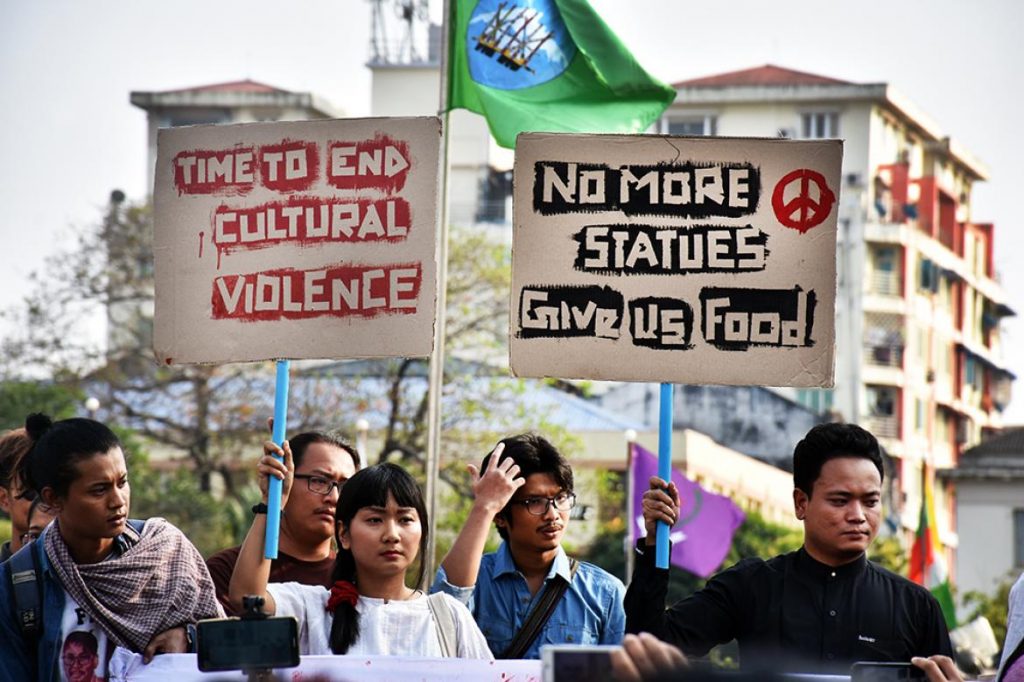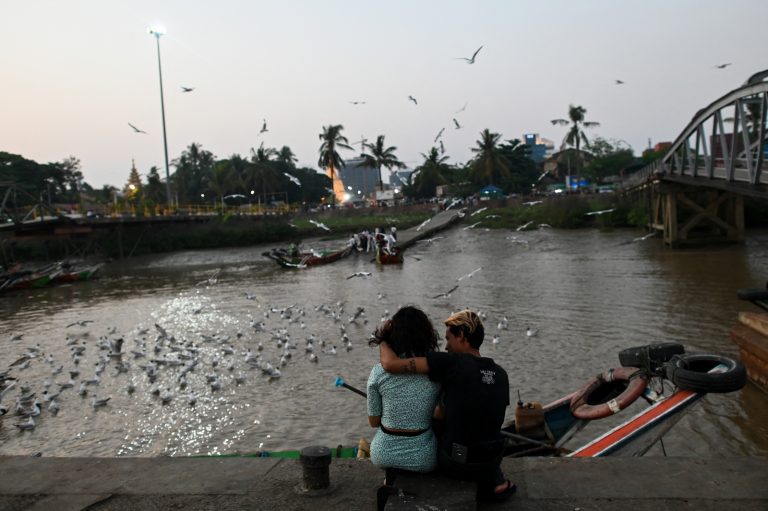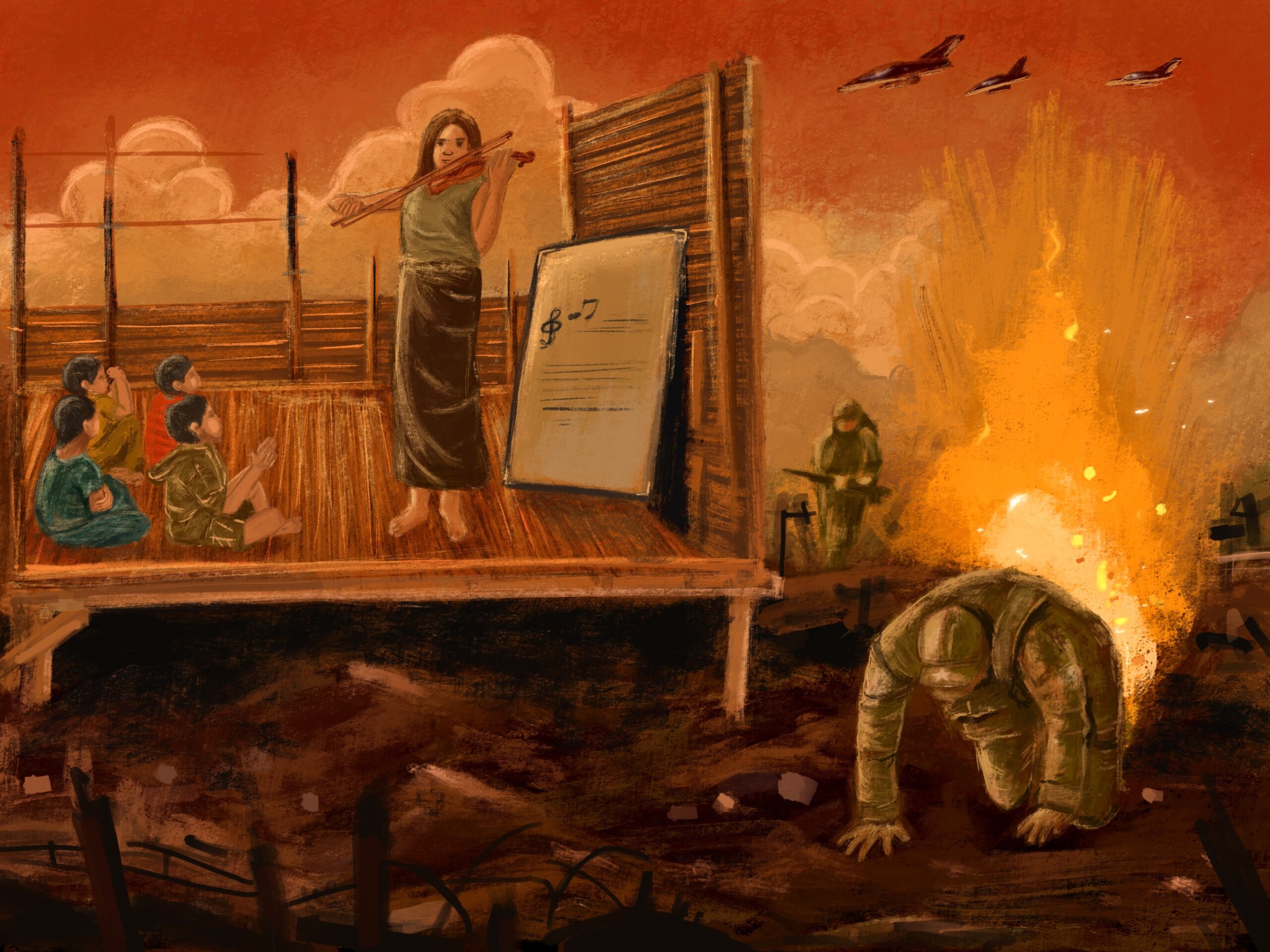The building of a statue of General Aung San in Kayah State highlights the continued vulnerability of ethnic minority identity to domination by the majority Bamar.
By KYAW HTUT AUNG | FRONTIER
IN 2018, a plan was announced to build a statue of General Aung San in the Kayah State capital Loikaw. Despite repeated objections from locals and ethnic minority organisations – and protests that landed organisers in legal trouble – the statue now stands tall in Kayah State as a tangible example of how vulnerable non-Bamar ethnic groups are to being dominated by the interests and identity of the majority Bamar (who are also referred to as Burmans).
Since independence, non-Bamar ethnic groups have faced institutionalised threats towards their identity, literature, culture and history. Seventy years of ethnic minority armed struggle against the Bamar-dominated central government is but one indication of this.
Bamar often claim they have been equally subject to repression from their own government. The Bamar, it should be noted, exhibited immense courage and sacrifice in leading the 1988 democratic uprising and the Saffron Revolution, both of which ended in ruthless crackdowns by the military. Yet ethnic minority regions have endured far worse, including killings, rapes and civilians being used as human shields and minesweepers, to name just a few abuses.
Some scholars argue that this experience of repression, albeit not to the same degree and frequency as with minority groups, has created among ethnic Bamar an inability to recognise the privileges they enjoy, and the extent to which non-Bamar are deprived of them. This leads to a denial of the longstanding and institutionalised repression of non-Bamar.
Support more independent journalism like this. Sign up to be a Frontier member.
It is not my intention to blame ethnic Bamar, but it is important to point out that many studies have highlighted their invisible but institutionalised privilege. Than Toe Aung’s recent article in Frontier, “Identity crisis”, covered this phenomenon.
It is important to note that the Karenni States, which covered most of what is now Kayah State, were never fully incorporated into British Burma, and remained independent. The people of Kayah have their own history, literature, culture and language to protect.
But the ethnic minorities of Kayah State are not the only victims of this Bamar chauvinism.
A statue of General Aung San was also unveiled amid controversy and protest in Kachin State in 2017, and was later attacked. Further north, in Putao District of northern Kachin State, we find another example. The Kyauk Nagar (Stone Dragon) site, which locals consider a unique source of oral history and religious belief, has been turned into a Buddhist stupa – without the consent of or even consultation with residents, who are predominantly Christians.
In Mon State, there were large protests in early 2017 over the Union government’s decision to name a new bridge after Aung San, despite the objections of locals.
Meanwhile, in central Myanmar, the literature, religion, culture, language and identity of the Buddhist Bamar remain intact and even expand. The Bamar do not need to fear threats from external forces.
General Aung San is undeniably a national icon due to his struggle for independence, but it is still hard for non-Bamar to welcome his statue because of the yet unfulfilled promises given in the Panglong Agreement of 1947. Since independence, non-Bamar ethnic groups have regularly demanded equal rights, equal opportunities and self-determination but in response have received only repression, violence and armed conflict.
The time for change is now. As Dr Matthew Walton, who was the inaugural Aung San Suu Kyi senior research fellow in modern Burmese studies at St Antony’s College, Oxford, has warned, “without attention to continued differential treatment of non-Burmans in many parts of the country as well as the privileged position of Burmans with regard to the national ‘Myanmar’ identity, ethnic reconciliation in Myanmar will remain elusive.”
In a democracy, the voice of the majority matters most. But in the Western world, out of the consciousness of racial disparity, the (typically white) majority regularly stands for the rights of minority groups who could otherwise be denied basic rights. In Myanmar, well above 65 percent of the population is Bamar. They have the power to make the loudest call for reform or change.
The Bamar have experienced their own suffering; it’s time for them to equate it with the suffering of non-Bamar communities, and show empathy for non-Bamar in their defence against domination in terms of identity, culture, religion, language and literature. In doing so, perhaps they can draw on their own experience nearly a century ago, when they felt their own existence was under threat from the imposition of colonial values.
In order to protect their interests, culture and identity, nationalist leaders formed the Dobama Asiayone (We Burmans Association) in 1930. The intention is clearly inscribed in their famous slogan: “Burma is our country, Burmese literature is our literature, Burmese language is our language. Love our country, raise the standards of our literature, respect our language.” The organisation’s song, “Kaba Ma Kyay” (“Till the End of the World”), was a symbol of the independence struggle and was adopted as the national anthem upon independence in 1948.
Is it too much to ask that the Bamar, by equating their own suffering with that of non-Bamar, and recalling the struggle of the Dobama Asiayone, show empathy for non-Bamar and their objections to aggressive cultural domination?
Speaking at the 71st Kachin State Day ceremony in Myitkyina last month, State Counsellor Daw Aung San Suu Kyi said that “[we] need to develop the sense that an ethnic person’s pain is also the pain of the other[s] in this union”. Perhaps it is time for more Bamar people – members of her own government included – to heed Aung San Suu Kyi’s words.







